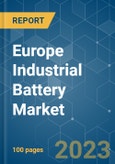COVID-19 moderately impacted the market in 2020. Presently the market has now reached pre-pandemic levels.
Key Highlights
- Declining lithium-ion battery prices, increasing demand from data centers and telecom sectors, along with rising renewable energy integration are some of the major factors driving the market.
- However, factors such as uncertainty in raw material prices and availability of raw materials, such as cobalt, lead, and lithium, are likely to curtail the market growth rate during the forecast period.
- The rising focus on technologically advanced batteries and the use of artificial intelligence in the R&D phase of battery manufacturing is likely to create a massive opportunity for the battery companies to invest and redirect their resources to make a breakthrough battery technology.
- Germany is expected to be the largest market during the forecast period, owing to the modest growth in the country’s manufacturing/industrial sector, which requires industrial batteries for its smooth functioning.
Europe Industrial Battery Market Trends
Lithium-ion Battery (LIB) Technology to Witness Significant Demand
- Lithium-ion battery (LIB) is expected to witness significant growth in the industrial battery market over the forecast period, majorly due to its favorable capacity-to-weight ratio. Other factors boosting the LIB adoption include its properties, like better performance, higher energy density, and decreasing price.
- The price of LIB is usually higher compared to other batteries. However, leading players in the market have been investing in R&D activities to improve LIB's performance and price to gain economies of scale. The emergence of new and exciting markets, such as Energy Storage Systems (ESS), for both commercial and residential applications is driving the demand for LIB.
- Lithium-ion batteries are witnessing massive demand in the battery energy storage market due to declining prices. Also, lithium-ion batteries are expected to hold the most significant share in the battery energy storage market soon, as they require little maintenance, are lightweight, and have a reliable cycle life, high energy density regarding volume, and high charge/discharge efficiency.
- Lithium-ion forklift batteries provide an extra edge to material handling applications by reducing labor costs and improving productivity. Lithium-ion forklift batteries can be fast-charged in cold temperatures (even inside freezers) and can maintain their capacity in cold temperatures better than their lead-acid counterparts. The increasing demand for the fast delivery of products has also pushed for logistics and distribution improvements in emerging regions like North America, Europe, and Asia-Pacific. This, in turn, is likely to boost the demand for industrial li-ion batteries in the material handling industry in the coming years.
- According to United Kingdom Office for National Statistics, As of December 2021, the price index for batteries and accumulators manufactured stands as 104.8 PPI. Also, the price of lithium-ion batteries has fallen steeply over the past ten years. In 2021, the lithium-ion battery price was USD 111 per kWh. Lithium-ion battery prices are falling continuously, and the price decreased by 10% in 2021 compared to the price in 2020.
- Therefore, based on the above-mentioned factors, lithium-ion battery technology is expected to witness significant demand for the industrial battery market during the forecast period.
Germany to Dominate the Market
- Over the previous years, Germany has shown a sustained and robust performance in the manufacturing sector in three crucial ways. The first is the considerably large role played by manufacturing in the overall economy, the second is job creation (the manufacturing industry has been continuously creating job opportunities), and the third is the industry's contribution to global exports.
- The manufacturing sector is expected to drive the demand for industrial batteries to be used in forklifts, emergency lighting, and control systems (backup power).
- Germany stands as the largest economy in the European Union and has a relatively robust internet ecosystem. Further, the demand for industrial batteries is expected to benefit from the developments in the country's telecommunication sector. The total revenue of the telecommunications sector in Germany was estimated to be almost USD 26.3 billion in 2021.
- The leading German telecommunication companies, based on revenue, are Deutsche Telekom, Vodafone Germany, Telefonica Germany, and E-plus. In addition, by the end of 2021, Germany had roughly 58,000 telecom towers (macro structures).
- In Germany, more than 80% of the companies are estimated to witness a high level of digitization along their value chain by 2025. In addition, 20% of the companies already consider themselves highly digitized. Among the leaders in digitization is the automotive industry, which already has significantly higher levels of automation.
- Therefore, based on the above-mentioned factors, Germany is expected to positively impact the industrial battery market during the forecast period.
Europe Industrial Battery Market Competitor Analysis
The Europe Industrial Battery Market is moderately fragmented. Some of the major players (not in a particular order) include Exide Industries Ltd, GS Yuasa Corporation, East Penn Manufacturing Company Inc., Panasonic Corporation, and Saft Groupe SA.Additional benefits of purchasing the report:
- The market estimate (ME) sheet in Excel format
- 3 months of analyst support
This product will be delivered within 2 business days.
Table of Contents
Companies Mentioned (Partial List)
A selection of companies mentioned in this report includes, but is not limited to:
- C&D Technologies Pvt. Ltd
- East Penn Manufacturing Company Inc.
- Exide Industries Ltd
- GS Yuasa Corporation
- Panasonic Corporation
- Saft Groupe SA
- Robert Bosch GmbH
Methodology

LOADING...










